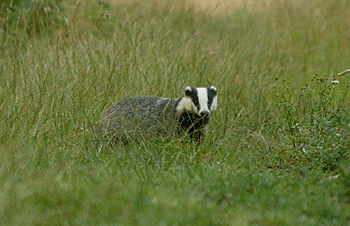Badger predation: A golden opportunity

According to Professor Ian Boyd, chief scientific adviser to DEFRA, the proposed badger cull could provide a unique opportunity to examine the impact this may have on songbirds and other species. The UK charity SongBird Survival has discussed this aspect with Professor Boyd and Owen Paterson, the Environment Secretary, and offered to help fund such a project, being committed to restoring the huge decline in our songbird population.
Farming methods and habitat used to be blamed for this decline but these are actually improving, with 70 per cent of farmland in agri-environment schemes and with large increases in hedge and tree planting. The doubling of all predator populations, however, such as crows, cats, magpies, birds of prey, grey squirrels, foxes and badgers over the past generation is more worrying. There is strong evidence that predation can have a serious effect on ground-nesting birds and waders yet there is a lack of quality science on the impact on farm and woodland songbirds.
The badger conundrum
The badger is Britain?s largest carnivore, a giant member of the weasel family and yet is our most protected mammal under the Protection of Badgers Act l992. Hardly an endangered species, they now outnumber foxes ? and population estimates have ranged from 288,000 to more than 400,000, with numbers growing strongly over recent decades. The proposed pilot cull was postponed last year because numbers in the target areas were grossly underestimated, so all previous population numbers may prove to be very conservative.
One study has already shown that badgers are limiting the populations of hedgehogs, which forage for similar foods. Yet compared with virtually all other mammalian and avian predators, relatively little research exists on the impact of badgers on birds. According to the Badger Trust, birds make up about eight per cent of their diet (by frequency of occurrence) for most of the year and this is largely confirmed by the few other studies that can be found. It is not known how much of this figure might be accounted for by carrion.
One study indicated that 19 species are taken by badgers as well as their eggs and young.
Skylark nest predation
Another piece of evidence is contained in the Sustainable Arable Farming For an Improved Environment (SAFFIE) project which was completed in 2007. This was funded by DEFRA and all the main conservation bodies. It included a nest camera study of skylark nests undertaken by the RSPB. This found that over half the skylark nest predations were carried out by badgers, yet this was not widely publicised.
The postponement of the badger cull to examine the impact on Bovine TB provides a unique opportunity irrespective of the pros and cons of its primary aims. The manipulation of a predator population offers the best chance to examine its impact on prey populations. The RSPB itself states that predator removal experiments are the best. Now there is sufficient time to design simultaneous studies to examine the impact of badgers on songbirds, hedgehogs and bumblebees, all of them projects which may help to increase the acceptability of the badger cull with the public. Until now, the hurried nature of this project and all the controversy has rendered such an exercise impractical.
At least the cull should offer the chance to carry out research, which could include studies using other ecological survey data to detect effects on a variety of species, and also stomach content analyses to understand the make-up of a badger?s diet. Any such research might help to discourage the threatened disruption and perhaps lead to lower policing costs, thus saving public funds.
This type of research constitutes a critical test of our commitment to preserving biodiversity. But most conservation organisations are heavily conflicted on the issue and are extremely reluctant to support essential yet controversial research that could deliver uncomfortable solutions, potentially alienating their members and their large revenues. They also collaborate on a sentimental portrayal of wildlife in the media. And in an era of coalition politics, there are very few votes to be gleaned here.
A number of species in this country could already be heading for extinction ? the corn bunting, yellow wagtail, skylark and even the hedgehog. If they all end up like the Dodo then, quite simply, it will be too late to do the science.








